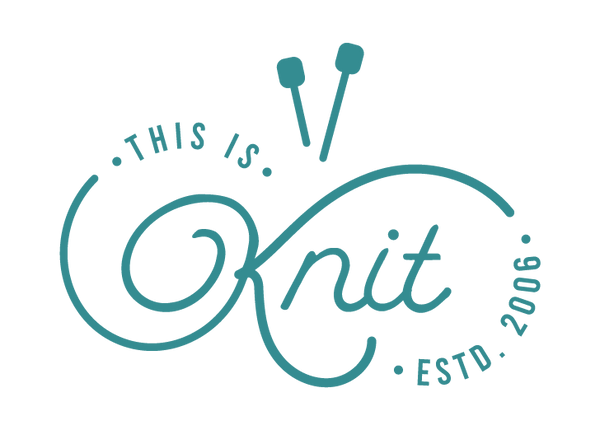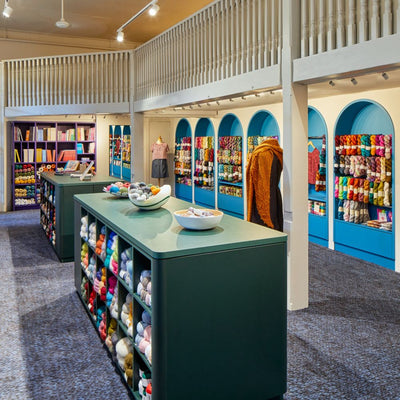Value added
January 23 2015 – thisisknit
 That's part of a Snawheid. It's a Kate Davies design, so of course the pattern is gorgeous, but this hat here? It's just a bit...meh. It's made with Navia Duo, which is lovely yarn and ideal for the job, and the stranded colourwork is very nicely done. Meh. Mustard and grey is a classic combination. Whatever: meh.
But this unfortunate hat is a perfect excuse for learning a little about how colour works. One of the things that distinguish colours is how far from white and black they are. It's called colour value. And if we're presented with two things of different colours and they have the same value, our brain notices and mutters "They're the same!" And in this case, the knitter's brain adds "That's a boring hat!"
Happily, there's a really easy way to avoid this which saves you time and money, and we were reminded of it by bioniclaura this week.
If you convert a colour picture to greyscale, you can see the values very clearly. So we did this with the picture at the top of the post, and here's the result:
That's part of a Snawheid. It's a Kate Davies design, so of course the pattern is gorgeous, but this hat here? It's just a bit...meh. It's made with Navia Duo, which is lovely yarn and ideal for the job, and the stranded colourwork is very nicely done. Meh. Mustard and grey is a classic combination. Whatever: meh.
But this unfortunate hat is a perfect excuse for learning a little about how colour works. One of the things that distinguish colours is how far from white and black they are. It's called colour value. And if we're presented with two things of different colours and they have the same value, our brain notices and mutters "They're the same!" And in this case, the knitter's brain adds "That's a boring hat!"
Happily, there's a really easy way to avoid this which saves you time and money, and we were reminded of it by bioniclaura this week.
If you convert a colour picture to greyscale, you can see the values very clearly. So we did this with the picture at the top of the post, and here's the result:
 The stranded colourwork vanishes completely. That's why this hat is uninteresting. Your brain notices that there's no value difference.
Of course, it would have been good (and would have saved time!) to check this before starting. Well, here's a picture of the two balls of Navia:
The stranded colourwork vanishes completely. That's why this hat is uninteresting. Your brain notices that there's no value difference.
Of course, it would have been good (and would have saved time!) to check this before starting. Well, here's a picture of the two balls of Navia:
 Converted to greyscale, that image looks like this, and you can tell it's not going to end well:
Converted to greyscale, that image looks like this, and you can tell it's not going to end well:
 Any digital camera will have a "monochrome" or a "black and white" setting, and so do most cameraphones - if you don't know where to find this, a quick look in your manual will help. Click over to that setting when you're choosing your yarn for colourwork and then snap a picture of your options. If they look like a good pairing when you subtract the colour, then you're on the right path, regardless of the type of colourwork you're planning.
Here's a couple of examples. Here's a likely-looking pair of yarns, both Malabrigo Rastita:
Any digital camera will have a "monochrome" or a "black and white" setting, and so do most cameraphones - if you don't know where to find this, a quick look in your manual will help. Click over to that setting when you're choosing your yarn for colourwork and then snap a picture of your options. If they look like a good pairing when you subtract the colour, then you're on the right path, regardless of the type of colourwork you're planning.
Here's a couple of examples. Here's a likely-looking pair of yarns, both Malabrigo Rastita:
 Changed to greyscale in the camera, this is the result, and it really does look promising, doesn't it?
Changed to greyscale in the camera, this is the result, and it really does look promising, doesn't it?
 And ta da! here's the finished product, a glorious Epistropheid hat!
And ta da! here's the finished product, a glorious Epistropheid hat!
 Given the black and white treatment, you can see why this works so well - the colour values are deliciously distinct. Happy brain, happy knitter!
Given the black and white treatment, you can see why this works so well - the colour values are deliciously distinct. Happy brain, happy knitter!
 If you're interested in reading more about colour theory in knitting, Knitty magazine has an excellent article here. Thanks again to Laura for inspiring this post!
By the way, this Epistropheid is now sporting a fake fur pompom from the new stock that we promised you last week, and Jacqui can't be persuaded to take it off!
If you're interested in reading more about colour theory in knitting, Knitty magazine has an excellent article here. Thanks again to Laura for inspiring this post!
By the way, this Epistropheid is now sporting a fake fur pompom from the new stock that we promised you last week, and Jacqui can't be persuaded to take it off!


1 comment
Very interesting! I had no idea about colour values. The trick with taking a photo of the yarns together in monochrome is excellent -thanks!